For a while I've been using custom cells (with their own nibs) for tables without issues. Now in a new project I see the need for a reusable custom view (not a cell) the would have a title, a button, and another UIVIew to hold more views. I'll call it "Section":

The idea would be to be able to use this Section in storyboards (using a UIView and setting the custom class accordingly). That way whatever views I put inside that UIView would actually be contained in the inner UIView of the Section.
I thought the hard part would be to actually get the views put using IB and Storyboard to actually reside in that inner UIView instead of the root UIView of Section. Turns out just making the custom view (without any inner views yet) is not working as I would have expected. Here is the code, which is based off of the dozens of custom cells I've done and have worked (though adjusted for the specific init methods of a generic UIView):
#import "SectionContainer.h"
@implementation SectionContainer
- (id)initWithFrame:(CGRect)frame
{
self = [super initWithFrame:frame];
if (self) {
// Initialization code
NSArray *nibArray = [[NSBundle mainBundle] loadNibNamed:@"SectionContainer" owner:self options:nil];
self = [nibArray objectAtIndex:0];
/*NSArray *nibRoot = [[UINib nibWithNibName:@"SectionContainer" bundle:nil] instantiateWithOwner:self options:nil];
[self addSubview:[nibRoot objectAtIndex:0]];*/
}
return self;
}
- (id)initWithCoder:(NSCoder *)aDecoder
{
self = [super initWithCoder:aDecoder];
if (self) {
// Initialization code
NSArray *nibArray = [[NSBundle mainBundle] loadNibNamed:@"SectionContainer" owner:self options:nil];
self = [nibArray objectAtIndex:0];
/*NSArray *nibRoot = [[UINib nibWithNibName:@"SectionContainer" bundle:nil] instantiateWithOwner:self options:nil];
[self addSubview:[nibRoot objectAtIndex:0]];*/
}
return self;
}
The matching XIB has its root view set to this custom class (just like I do in the custom cells)
THE PROBLEM
This custom class causes a EXC_BAD_ACCESS code=2 and from what I can tell by stepping through it, it's as if the class is being called recursively. Call after call after call to initWithDecoder is being made until the EXC_BAD_ACCESS error happens
WHAT I'VE TRIED
- Given the seeming recursive calls I tried another approach I saw that set the XIB's file owner to the Custom Class instead of the XIB's root View. This caused the following error:
'NSUnknownKeyException', reason: '[ setValue:forUndefinedKey:]: this class is not key value coding-compliant for the key sectionContainerView
- Tried a slightly different method (commented out in the code above) where the XIB's root is added to the custom class (addSubView) instead of being set to it. This didn't change anything, same recursive calls (or error above if that is set up)
I would REALLY appreciate some guidance on this. Thank you.